| Mid 20th Century Baker Microscope
An example of an underrated instrument that still has plenty of life and some old fashioned virtues.
By Paul James (uk) |
| Mid 20th Century Baker Microscope
An example of an underrated instrument that still has plenty of life and some old fashioned virtues.
By Paul James (uk) |
The trend of modernising microscope stands continues, yet the changes are often of style rather than of substance, which is one reason why so many amateur microscopists purchase older instruments. In these simple notes I describe a basic stand manufactured by C. Baker from the 1950's revealing some of the earlier practises of a bygone age which have disappeared from today's stands. This particular example is one of a series which had some subtle changes implemented into its design, yet remained essentially unaltered in style. It is surprisingly an underrated microscope as they rarely fetch the prices that other stands of British manufacturer have in recent times. I hope therefore that these notes will give those readers who are wanting a well made instrument, some insight into this unassuming example of a byegone age.
The Stand
As you can see above in the first photo its exterior lines are smooth and simple yet possess a utilitarian elegance which allows accurate machining of its main limb in manufacture and subsequent ease of handling in use. The first few moments of actually moving and using this microscope confirm that this is an instrument that will last several generations. Indeed after about 50 years there is little or no sign of use, save the understandable marking around its plain horseshoe foot, and a series of minor blemishes on the stage's surface.
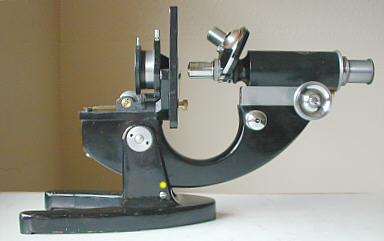 |
The ability of the stand to recline horizontally as seen above is a feature that evolved in the past when such positioning was required for photography. An adjustable pin stop is located in the limb and allows fine tuning of horizontal angle. A great proportion of Victorian and early 20th photographs were taken in this mode, though of course pondlife imaging was a bit of a bother without special cells!
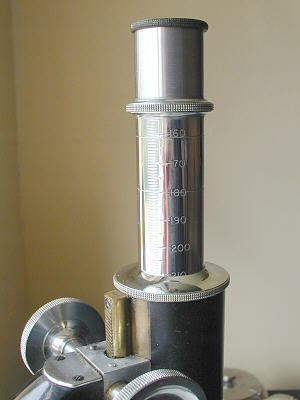 |
All the controls are soberly smooth and devoid of backlash or play. The fine focus mechanism is a delight to use and is neither too stiff or too free and would be capable of adjusting the x100 oil immersion objective when fitted to the nosepiece. The rack mechanism is unusual in having a circular cross section matching that of the limb as can be seen above. This utilises part of the tube as a sliding bearing which is also circular of course and such was the accuracy of its initial machining that this combination of curved/linear surfaces are still mating perfectly to this day. Note too the extending draw tube which not only caters for 160mm objectives but those of up to 210mm, which are still to be found for sale today and cheaply too. Smoothly collapsing or extending, this example of draw tube with a chromed surface is very positive and is the easiest I have ever used.
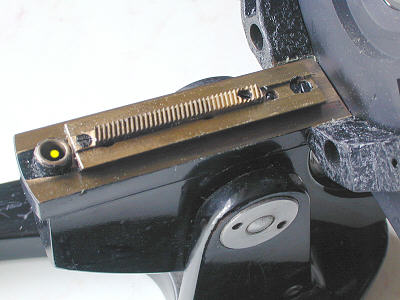 |
The substage assembly is simple and is dovetailed to this solid example of bronze/brass machined rack as seen above. Note the mirror gimbal hole which allows for its removal during horizontal photography
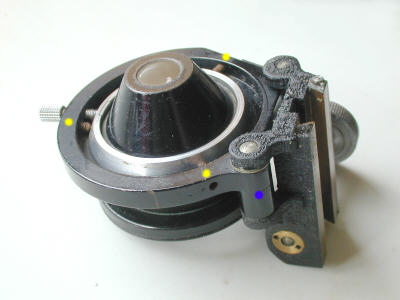 |
The condenser is a dry Abbe of about 1.0na and can be centred by adjusting three grub screws as shown above. This is not ideal, for it is not a quick user method since it takes several minutes to accomplish with an Allen key, but once centration is achieved there is little need to readjust for 99% of observational use. Undoing the chromed thumb screw releases the condenser allowing for other substage optics to be inserted such as for phase contrast and darkfield. The iris is straightforward in use, and also a convenient 'click stop' feature gimballed as shown, ensures the speedy swinging out of the condenser for very low power use. The latter is very positive and well made.
Optics
Having established that the stand is very well made, though a trifle sparse in user adjustment refinements, I can state with confidence that the optical side of things is very capable of delivering quality images. The images were almost 'plan' flat within the modest field of the x10 Huygenian eyepiece, though eye relief was only moderate, being typical of this 50's offering. The objective's somewhat higher na than those of contemporary optics again reveals signs of earlier optical design concepts. Other revealing signs of its age can be seen from the objective's designations, where both the modern x40 and x10 and old 1/6" and 2/3" symbols can be seen, and of course a lack of a sprung nose for the x40. The 45mm low power ( about x 3 ) is a simple achromatic doublet and is fine for low power scanning of slides though it is not parfocal with the other two objectives.
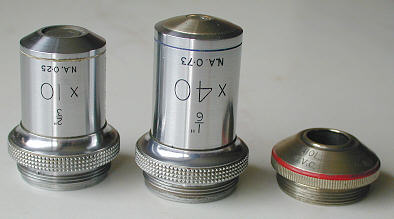 |
Indeed this reminds me of the cosmetic quality of the bodies of the chromed objectives as this close-up below only hints at which is exemplary, with no 'sham' whatsoever. These are perhaps the most mechanically pleasing and most solidly constructed optics I own. I like the simplicity, beautiful fine ground 'chrome' finish, precision etchings and the stout knurled shoulders of these objectives :-.
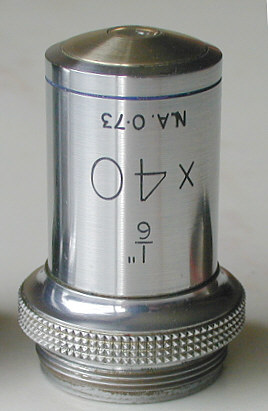 |
DIY Stage Clips
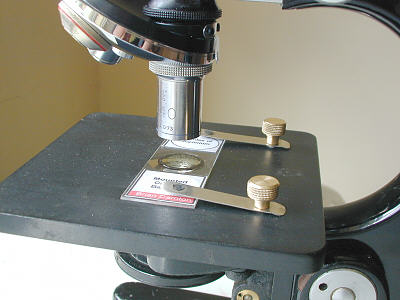 |
You might recognise that the stage clips are not original: In fact I made them since this 'scope came to me without clips, but mine are shorter than the traditional sort and have hard rubber grommets at the ends to raise the metal strips above the glass and reduce wear on the labelling as well.
Final Notes
Put simply: This microscope is capable of not only introducing the beginner to microscopy who can rapidly come to terms with its simple operation, but also maintaining the interests of a more skilled observer with its inherent quality. A mechanical stage would probably be the first upgrade for a long term owner, and perhaps electric illumination later?
Lacking in exposed brass surfaces does not affect its principal role of providing quality imagery. That said, I think there is a distinct uneffacing appeal to its black enamel gloss and chromed finish which in my opinion exudes a workmanlike elegance to the stand which has clearly originated out of that era just prior to the use of plastics, and before draughtsman threw away their French curves!
Mr C. Baker's modest example of a compound microscope described here, has very few shortcomings but many virtues, and those interested in buying and using one should consider its intrinsic replacement value in today's terms. With that in mind, its longevity, reliability and quality should make the loss of about 1/5 of a week's wages seem a trifle.
| All comments welcome by the author Paul James |
Microscopy
UK Front Page
Micscape
Magazine
Article
Library
Please report any Web problems or offer general comments to the Micscape Editor.
Micscape is the on-line monthly magazine of the Microscopy
UK web
site at Microscopy-UK